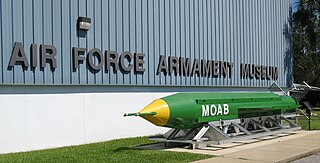
The McDonnell F-101 Voodoo is a supersonic jet fighter designed and produced by the American McDonnell Aircraft Corporation.

The Lockheed F-94 Starfire was a first-generation jet powered all-weather day/night interceptor aircraft designed and produced by Lockheed Corporation. It was the first operational United States Air Force (USAF) fighter equipped with an afterburner as well as being the first jet-powered all-weather fighter to enter combat during the Korean War.

The Douglas AIR-2 Genie was an unguided air-to-air rocket with a 1.5 kt W25 nuclear warhead. It was deployed by the United States Air Force and Canada during the Cold War. Production ended in 1962 after over 3,000 were made, with some related training and test derivatives being produced later.

The McDonnell CF-101 Voodoo was an all-weather interceptor aircraft operated by the Royal Canadian Air Force and the Canadian Forces between 1961 and 1984. They were manufactured by the McDonnell Aircraft Corporation of St. Louis, Missouri for the United States Air Force, and later sold to Canada. CF-101s replaced the obsolete Avro CF-100 Canuck in the RCAF's all-weather fighter squadrons. The Voodoo's primary armament was nuclear AIR-2A Genie unguided air-to-air rockets, and there was significant political controversy in Canada about their adoption. Although they never fired a weapon in wartime, the CF-101 served as Canada's primary means of air defence from Quick Reaction Alert facilities at Canadian airbases. The CF-101s were retired in the 1980s and replaced with McDonnell Douglas CF-18 Hornet fighters. Many examples are preserved in museums and parks in Canada and the United States.

The Wings Over the Rockies Air and Space Museum (WOTR) is located on the former Lowry Air Force Base in Denver, Colorado, United States. The museum preserves the history of Lowry AFB's operations from 1938 to 1994 in its collections, archives, and research library.

The Strategic Air Command & Aerospace Museum is a museum focusing on aircraft and nuclear missiles of the United States Air Force during the Cold War. It is located near Ashland, Nebraska, along Interstate 80 southwest of Omaha. The objective of the museum is to preserve and display historic aircraft, missiles, and space vehicles, and provide educational resources.

The Air Force Armament Museum is a military aviation museum adjacent to Eglin Air Force Base in Valparaiso, Florida, dedicated to the display of Air Force armament. It is supported by the private, non-profit Air Force Armament Museum Foundation.

Hill Aerospace Museum is a military aviation museum located at Hill Air Force Base in Roy, Utah. It is dedicated to the history of the base and aviation in Utah.

The 101st Air Refueling Wing is a unit of the Maine Air National Guard, stationed at Bangor Air National Guard Base, Bangor, Maine. If activated to federal service with the United States Air Force, the 101 ARW is operationally-gained by the Air Mobility Command (AMC).

The Pueblo Weisbrod Aircraft Museum is a non-profit aviation museum located in Southern Colorado. It was founded in the mid-1970s by former Pueblo City Manager Fred Weisbrod. The museum is made up of two hangars that were built in 2005 and 2011. The hangars house several of the museum's aircraft along with thousands of artifacts dating from World War I to modern day. PWAM is home to the International B-24 Memorial Museum and the Southern Colorado Space Museum and Learning Center. There are several historic military vehicles in the museum's collection, many of which are still in operational condition. The museum is located six miles east of Pueblo, Colorado on US Highway 50 at the Pueblo Memorial Airport, occupying space on what was the Pueblo Army Air Base during World War II. It is managed and maintained by the Pueblo Historical Aircraft Society.

The 60th Fighter Squadron is a United States Air Force unit that is part of the 33d Fighter Wing at Eglin Air Force Base, Florida; It is tasked with training pilots on the Lockheed Martin F-35A Lightning II.

The 62d Fighter Squadron is part of the United States Air Force 56th Operations Group at Luke Air Force Base, Arizona. It operates the Lockheed Martin F-35A Lightning II aircraft conducting advanced fighter training.

The 84th Flying Training Squadron was part of the United States Air Force 47th Flying Training Wing based at Laughlin Air Force Base, Texas. It operated Beechcraft T-6 Texan II aircraft conducting flight training.

The 29th Training Systems Squadron is an active United States Air Force unit. It is assigned to the 753d Test and Evaluation Group, at Eglin Air Force Base, Florida.

The 4735th Air Defense Group is a discontinued United States Air Force organization. It was assigned to the Boston Air Defense Sector at Otis Air Force Base, Massachusetts, where it was last active in 1959.

The 123d Fighter Squadron is a unit of the Oregon Air National Guard 142d Fighter Wing located at Portland Air National Guard Base, Oregon. The 123d is equipped with the McDonnell Douglas F-15C Eagle.

The Shearwater Aviation Museum is an aviation museum located at CFB Shearwater in Shearwater, Nova Scotia. The museum acquires, conserves, organizes, researches and interprets to Canadian Forces personnel and the public at large for their study, education and enjoyment, artifacts and documents which exemplify the history of Canadian maritime military aviation.

The Air Mobility Command Museum a military aviation museum located at Dover Air Force Base in Dover, Delaware dedicated to the history of the Air Transport Command, Military Air Transport Service, Military Airlift Command and Air Mobility Command.

The Minnesota Air National Guard Museum is an aviation museum located at Minneapolis–Saint Paul Joint Air Reserve Station in Fort Snelling, Minnesota. It is dedicated to the history of the Minnesota Air National Guard.























